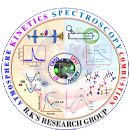Formyl (HCO) radicals were generated in situ in the gas phase via the photolysis of glyoxal in N2 at 248 nm using the pulsed laser photolysis–cavity ring-down spectrometry technique, and the absorption cross-section of the radical was measured to be σHCO = (5.3 ± 0.9) × 10–19 cm2 molecule–1 at 298 K and 615.75 nm, which was the probing wavelength. The kinetics of the reactions of HCO radicals with ethyl formate (EF) and ethyl acetate (EA) were investigated experimentally in the temperature range of 260–360 (±2) K at a pressure of 60 Torr/N2. The absolute rate coefficient for the reaction between HCO and EF was measured to be (298 K) = (1.39 ± 0.30) × 10–14 cm3 molecule–1 s–1 at ambient temperature, whereas that for the reaction of HCO with EA was measured tobe (298 K) = (2.05 ± 0.43) × 10–14 cm3 molecule–1 s–1. The reaction of HCO with EA was faster than that with EF, which might be due to the greater stability of the formed radical intermediate due to hyperconjugative and inductive effects. The dependency of the measured kinetics on experimental pressures and laser fluences was examined within a certain range. To complement the experiments, kinetics of the title reactions in the temperature range of 200–400 K were deciphered theoretically via the canonical variational transition-state theory with small-curvature tunneling and interpolated single-point energy (CVT/SCT/ISPE) method using a dual-level approach at the CCSD(T)/cc-pVTZ//MP2/6-311++G(d,p) level of theory/basis set. A good degree of agreement was detected between the rate coefficients measured experimentally and those calculated theoretically both at room temperature and throughout the range of temperatures studied. The kinetic branching ratios and thermochemistry of the reactions were investigated to understand the thermodynamic feasibility and kinetic lability of each pathway throughout the studied temperatures. Atmospheric implications of these reactions of HCO radicals are also discussed.
-
Call
-
E-mail
Journal Details
1. Experimental and Theoretical Investigation of Reactions of Formyl (HCO) Radicals in the Gas Phase: (I) Kinetics of HCO Radicals with Ethyl Formate and Ethyl Acetate in Tropospherically Relevant Conditions..
K. Mondal & B. Rajakumar J. Phys. Chem, , 6135–6147, 126(36)
